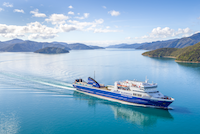Fishing in New Zealand
Freshwater or salt - New Zealand is an angler's paradise offering some of the best opportunities for fishing in beautiful, isolated and pristine locations. In a country with such a vast coastline and hundreds of rivers and lakes, it is little wonder that fishing is a popular pastime for New Zealanders. Anglers come from all over the world to try their luck in the crystal clear waters.
New Zealand was put on the big game fishing map after a visit by legendary American writer Zane Grey in the 1920's. Excellent salt water game can be found off the East Coast of the North Island as far south as Whakatane. Catches include tuna, blue and striped marlin, yellowtail kingfish and shark.
Sea fishing in New Zealand offers almost guaranteed fish, with strict regulations on daily allowable catch, ensuring sustainable resources. This type of New Zealand fishing runs the gamut from fishing off wharves to big game fishing in the Bay of Islands.
Inland, New Zealand's crystal clear waters, uncrowded rivers and lakes offer exciting opportunities for trout fishing. From the volcanic Taupo-Rotorua region in the central North Island, to the glacial formed lakes of west Otago and Fiordland.
Safety Tips

The following are some tips to help make the most of fishing New Zealand's rivers, lakes and coastlines:
- Each passenger should have a correctly fitting buoyancy vest (life jacket) when boating. Remember they only work when you are wearing them!
- When hiring a boat, familiarise yourself with the craft (location of life jackets, radio equipment, correct use of the motor, bilge pump etc), and let someone know of your intentions.
- Avoid excessive alcohol when operating a boat - just like driving a car, they don't mix!
- To fish for trout and salmon, or hunt game birds, you need a permit from Fish and Game New Zealand. There are 12 regional offices and affiliated outlets able to issue licences nationwide.
- Permits are required to hunt on conservation land. These are easily obtained from Department of Conservation offices nationwide (see a local telephone directory for an office nearest to you).
Catch and Release
Increases in catch rates from rivers with 'catch and release' regulations have been spectacular in many parts of North America, most notably Montana. 'Catch and release' was introduced to New Zealand by visiting American fly-fishers and is a predominant philosophy today, particularly in pristine wilderness rivers.
The 'catch and release' philosophy is in keeping with New Zealand's dedication to conservation and sustainable fishing. Even in non-release areas, many anglers adopt the catch and release principle, or simply bag only their last catch of the day to take home for eating.
When fishing the catch and release method, anglers should realise that prolonged handling decreases the fish's chances of survival. Some tactics to ensure fish live include using tackle strong enough to bring the fish in quickly, so it doesn't get overtired, avoiding damage to the eyes, gills, fins and body, and keeping the fish in the water so it can breathe.
If you want to measure the fish, do it against your rod or take a photo holding it in the water. When the fish is released, it should be supported from underneath and let go facing the current. High summer temperatures lessen the fish's chance of survival too, so care should be taken to quickly return fish to the water by gently lowering it in.
The Nelson-based Cawthron Institute has undertaken an interesting study on the effects of 'catch and release' fishing.
Fishing by Moonlight

Many Pakeha, as well as Māori, swear by the efficacy of the Māori fishing calendar, in deciding when to fish. The Māori fishing calendar says that greater feeding activity occurs during low tide peaks rather than high tide, and that a full moon is a bad time to fish especially if there is a lot of phosphorescence on the water.
It also says fish are much hungrier during a spring tide and just before a storm is about to break, that bigger fish catches are usually made during the day 'peak period' rather than the night one, and that 'peak fishing' doesn't necessarily coincide with dawn, dusk, high or low tides.
Ken Ring is a mathematician with a passion for numbers. He is also a long-range weather forecaster whose month-ahead forecasting columns are syndicated throughout New Zealand, and are used by farmers, fishermen, pilots, travellers and all event organisers. Ring has taken the Māori fishing calendar one step further over his years of research, predicting the weather through lunar activity.
Fishing Lodges
New Zealand offers great sporting style lodges, these vary from wilderness lodges set amidst grandeur to intimate retreats where anglers are the only guests.
The cuisine is often exceptional, the welcome and hospitality warm and relaxed, and the fishing advice freely available through resident guides. View our great selection of lodge accommodation in New Zealand.
Free Topographic Maps For Fishing
Official New Zealand Topographic Maps available for free online through the new website www.nztopomaps.com
The online service allows users to quickly find, view and print topographic maps for planning recreational fishing or other activities, and includes a place name search function. www.nztopomaps.com provides fast and simple access to the 'NZTopo' Topographic Map Series, which are traditionally purchased as printed paper maps.
The service is also available on smartphones such as iPhone devices, and makes use of their in-built GPS capabilities. Screen shots from an iPhone to demonstrate the use of www.nztopomaps.com on a smartphone are available from our media resources page at www.nztopomaps.com/media/.
Click here to view tourism operators for fishing in New Zealand.













